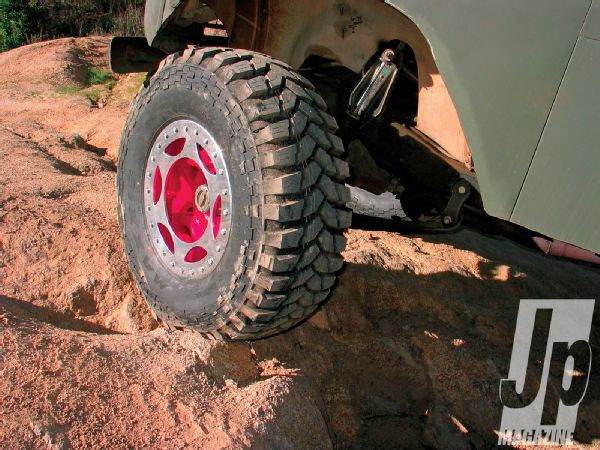
 Christian Hazel
Brand Manager, Four Wheeler
Christian Hazel
Brand Manager, Four Wheeler
Listen, we're not gonna lie to you. This is one friggin' heavy wheel and tire combo. The 35x12.50R17LT Maxxis Trepador radials mounted on our set of 17x8.5 Walker Evans Racing beadlocks tipped the scales at just a tick under 120lbs each. That's some serious weight to be throwing around under your Jeep, so we expected big things from the combo off-road.

For starters, Maxxis calls the M8060 Trepador an "Extreme Off-Road Tire." So it was a bit puzzling to us that the only two sizes available with a lighter 35psi max pressure rating are the 35x12.50R15LT and 40x13.50R17LT. All the other Trepador Radials are rated at 50psi or 65psi, which you'd expect from a tire designed for heavy-hauling and towing duties. Maxxis doesn't provide a lettered load-range rating on the tire sidewall or website, but with a 3,000lb load rating and a maximum pressure of 50psi, we'll consider our 35x12.50R17LT size equivalent to a load-range D tire. With three-ply polyester sidewalls, hugely thick bead bundles, and a gnarly six-ply tread weave (three-polyester, two-steel, one-nylon), they were a bear to mount on our beadlocks at home-but not impossible. We're betting that the thick bead bundles will help tire retention on non-beadlock rims at low pressures.
On the street, we found our correct contact patch for our estimated 3,200lb Jeep at an absurdly low 14psi thanks to the tires' 3,000lb load rating. Other than the noticeable weight, the Trepadors rode smoothly even with no balance weights. You can hear the tread on the street, but it's not an overpowering howl or drone as with a more-aggressive mud tire. Rather, just a simple hum that you can easily ignore. In hard cornering and braking we did note a bit of tread squirm, but only when pushing to find the limits of adhesion. In short, this is a race on Sunday, commute on Monday tire: you'll be pleased with them on your daily-driver.
But you don't buy a tire of this ilk for street use. Even though we had beadlocks, we didn't find the need to air down past 10psi for most of our testing. Right out the gate the Trepadors offered superb traction. Once we worked in the sidewalls for a couple hours, the Trepadors began flooring us with their grip in virtually any terrain we threw at them. Unfortunately, we didn't encounter any mud, but soft, sticky soil climbs were a non-issue. Whether with slow-speed finesse or throttle-hammering violence, the Trepadors grabbed dirt climbs like glue and gave sure-footed grip under braking on the way down. And the same is true of the tire's performance on the decomposed granite boulder fields in our test area. With firm yet flexible lugs, good voids, and lots of little biting surfaces on the tread edges, traction on rock seems a foregone conclusion. Dropping the pressure again to 5psi increased the sidewall bulge, but made no noticeable difference in traction-which is to say they worked exceptionally well even at higher pressure. One drawback we did note is the firmness of the lugs translated into a moderate propensity to chunk the very leading edges in really sharp rock. However, the same would be true of most tires in similar conditions and overall we consider this a very high-survivability tire in the rocks. Despite numerous and brutal bashings, we couldn't hurt them. We're betting with more long-term testing these prove to be some of the most durable radials we've ever run in the rocks and harsh desert conditions.
Pros:
Cons: